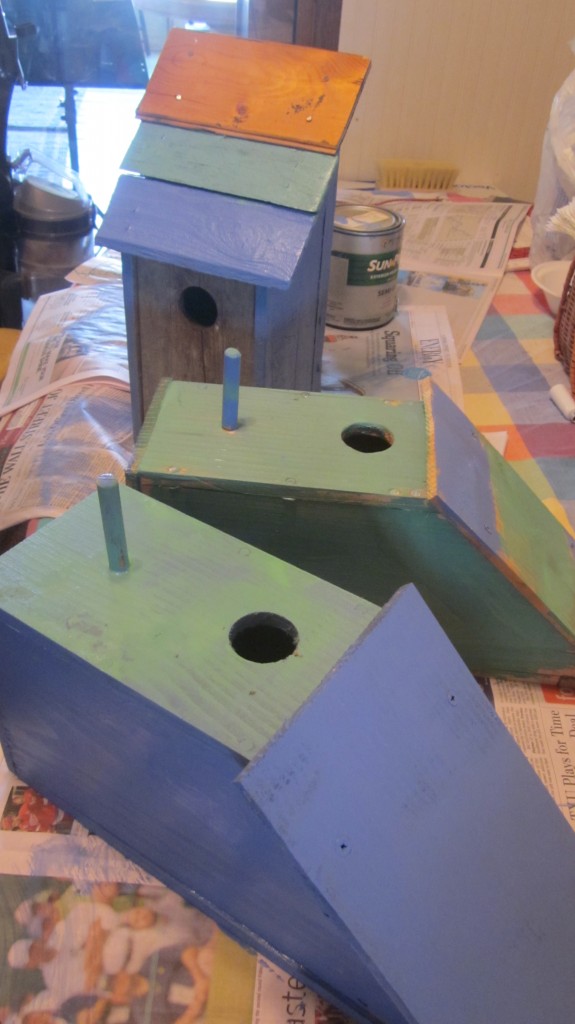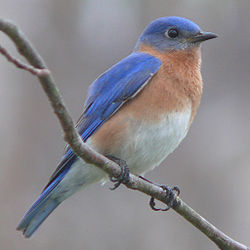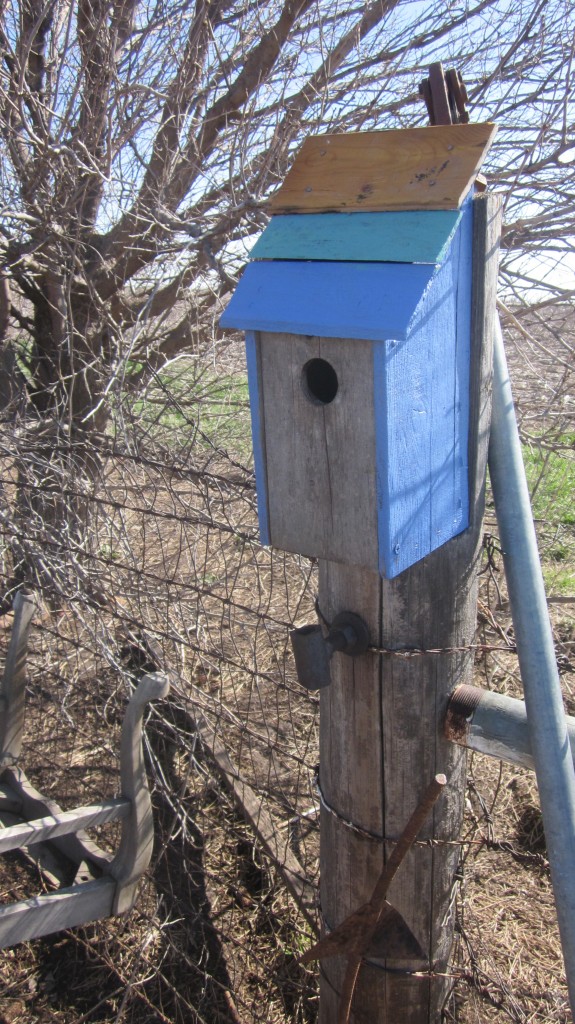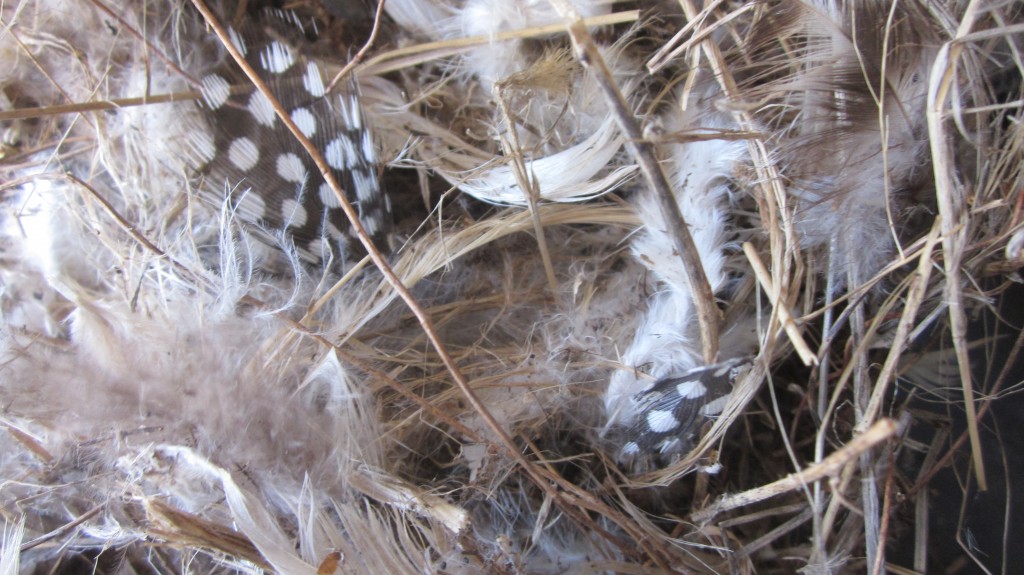4 Simple things you can do to attract bluebirds to your place

My dad surprised me by bringing these bluebird houses out to me a few days ago. Little Mack and I painted them–mostly blue, of course.
It’s a strange feeling that I experience in the late winter, when I hear the soft, sweet, peculiar sound of a bluebird’s warble. The birds are usually not visible, as they flit quietly from tree to tree, but my ears are finely tuned to that sweet sound, so I know that they are passing through. What it means to me is that winter is nearly over, and that the bluebirds are scouting out suitable places to raise their babies. I feel a clenching of the heart, a painful longing for spring and warmth and the color green, whenever I hear that sound.
It is possible to attract bluebirds to a proper nesting place in town, but they seem to prefer wide open spaces (as do I) so they are more commonly found in the countrysides here in Nebraska. But if you offer an attractive enough space in town and you coax some of these birds to nest in your yard, you’ll be in for a treat!
Bluebirds are sweetly quiet birds. You have to be attuned to their soft song to know that they are about. They are beautiful, but it’s a quiet beauty, and you will miss that flash of blue if you aren’t paying attention. They don’t own the flashy sharp beauty of the bright red cardinal, or the aggressive nature of the bluejay, or the chattery nature of the house sparrow. It’s unfortunate that you can miss them entirely if they are in your area.
But now, Gentle Reader, that you are reading this, you’ll know to watch out for them!
There are three types of bluebirds: Eastern, Western, and Mountain varieties. Bluebirds are a type of thrush, related to the robin, and all the species are migratory, though I’ve noticed bluebirds in our area from late winter through spring and summer, and into the fall. They go someplace warmer during our bitter Nebraska winters (again, as would I if I had a choice).
There are many reasons why you do want to attract bluebirds to your area, whether you live in town or in the country. First of all, they are underdogs, and we like to champion the efforts of underdogs, don’t we? I do. Because of the introduction of English sparrows and Starlings to the states in the late 1800s, and because of the loss of nesting areas, it is estimated that the numbers of these lovely songbirds went down by as much as 90% between 1920 and 1970. Secondly, bluebirds might be your new best friends if you have a garden, because they eat an astonishing amount of insects. They do eat a few other things–berries, mostly–but they live primarily on their insectivorous diet.
 Bluebirds are admirable family birds, and are fun to watch. The female will lay four to five light blue eggs that will take thirteen to fifteen days to hatch. The male will bring food to his mate and the young during the critical first few days of feeding. He will look like a tiny hawk, in his slumped hunting position, waiting patiently for an insect or beetle to show itself. Then he pounces on it and brings it back to his family.
Bluebirds are admirable family birds, and are fun to watch. The female will lay four to five light blue eggs that will take thirteen to fifteen days to hatch. The male will bring food to his mate and the young during the critical first few days of feeding. He will look like a tiny hawk, in his slumped hunting position, waiting patiently for an insect or beetle to show itself. Then he pounces on it and brings it back to his family.
Bluebird young will fledge in fifteen to twenty days. Even though the parents will keep feeding them, the fledglings can find their own food in about two weeks.
You will see some of the youngsters from the first brood bringing food to their new siblings. If I see bluebirds flying around together, I always try to sit down and watch the show. You may even spot the family returning in the following spring to scout out nesting areas.

My son Timothy hung our bluebird houses outside right away. This one is on a fencepost close to the chicken coop.
If you want to attract these lovelies to your property (and trust me–you do!) you need only attend to four simple things:
1. Food. Bluebirds consume a large amount of insects, especially when they are raising their babies. Insecticide use is, therefore, not encouraged. You can also put out suet, which bluebirds will eat. They will also eat elderberries and other small berries, so adding a few of these bushes to your landscape will encourage their nesting. (Or lots!)
2. Fresh water. All birds need fresh water for bathing and drinking, and if you live in colder areas and you want to keep them around over the winter, a water heater in your birdbath is essential.
3. Shelter. Bluebirds prefer older, larger trees with plenty of space in between them, so avoid planting thick and dense plantings of trees or bushes. They also like posts or small trees near their nesting boxes, for perching.
4. Nesting. Bluebirds prefer wooden nesting boxes of a certain dimension. You’ve probably seen them along country roads or in public parks. They are widely available in the shops where you might buy wild bird feed, or in your local farm store. Or you can find a plethora of styles online. Preferably nesting boxes should be installed in a spot with plenty of space around for flying, and about 4 to 7 feet off the ground. Since bluebirds are territorial, allow plenty of space between the boxes, if you put up more than one. Some sources say a minimum of 300 feet must be between the boxes.
You can also put out nesting materials–fabric scraps, pine needles, yarn, feathers–and watch your bluebird houses for signs that sparrows and starlings may be moving in. Don’t let them set up shop! Also, clean out the houses after each brood flies away, to make it attractive for the next nesting period.

Here’s the nest that I recently cleaned out of the nesting box that was near the chicken coop–I was tickled to find all the chicken and guinea feathers! It’s probably a sparrow nest.
That’s all you need to know, Gentle Reader, to attract bluebirds to your place. Put up a couple of nesting boxes, provide some food and water, and listen for that soft warble, and watch for that flash of blue! You’ll be glad that you did. But before you do, one last thing–a poem about bluebirds for you to enjoy.
The Bluebird
by John Burroughs
A wistful note from out the sky,
“Pure, pure, pure,” in plaintive tone,
As if the wand’rer were alone,
And hardly knew to sing or cry.But now a flash of eager wing,
Flitting, twinkling by the wall,
And pleading sweet and am’rous call,–
Ah, now I know his heart doth sing!O bluebird, welcome back again,
Thy azure coat and ruddy vest
Are hues that April loveth best,–
Warm skies above the furrowed plain.The farm boy hears thy tender voice,
And visions come of crystal days,
With sugar-camps in maple ways,
And scenes that make his heart rejoice.The lucid smoke drifts on the breeze,
The steaming pans are mantling white,
And thy blue wing’s a joyous sight,
Among the brown and leafless trees.Now loosened currents glance and run,
And buckets shine on sturdy boles,
The forest folk peep from their holes,
And work is play from sun to sun.The Downy beats his sounding limb,
The nuthatch pipes his nasal call,
And robin perched on treetop tall
Heavenward lifts his evening hymn.Now go and bring thy homesick bride,
Persuade her here is just the place
To build a home and found a race
In Downy’s cell, my lodge beside.
Hey, I’m linking up with the Barn Hop over at The Prairie Homestead. Come on over!
- Two-Mushroom Tart from the Kitchen of Chef William
- “More fish please,” says nobody at our house, EVER–until now


Lovely! If you ever need fabric scraps, GIVE A YELL! Goodness knows I have plenty. 🙂
Whenever we’ve tried to feed the birds we find we are a fast food joint for squirrels and chipmunks…oh… and black BEARS!!
Enjoy the day, chica!
Wow, black BEARS. I’ve gotta admit, I’m a little jealous! I’d love to see a black bear, as long as he wasn’t looking at me and thinking “lovely white meat for dinner there.”
I’m reminded of the old song, ‘Bluebird of Happiness’. I really enjoyed your picture of the beautiful bird. I’ve never seen one. We’ve got a lot of large blackbirds around our garden, attracted by bird feeders other people put out. I’ve noticed all the smaller birds have left, probably in fright.
Those large blackbirds would scare me away, too! Makes you wonder where all the songbirds, are, Francene?
I love bluebirds. We had them at our other place but since we moved I see them stop by to take a look at my humble offering of a home they never seem to stay long. I know we have a cardinal family in our bushes every year so not sure if that is the reason the bluebird doesn’t stay around.
Shawn, they are so pretty, aren’t they? One of my favorites!
I live just outside of Toronto and don’t believe I have ever seen a bluebird here. I have cardinals that visit each day and robbins, starlings. I will have to do some research to see if they in fact do come to our area. It is a realy joy to share nature and I appreciate you sharing about the bluebird. Thanks, Wendy
Wendy, it appears to me that the Eastern Bluebird (the same one that we have) has a habitat all the way up into your area. Here’s a website with more info: http://www.bluebirdnews.com/bluebird-species.htm
I sure learned a lot about bluebirds! I rarely see them and attracting them seems like a wonderful idea. And the poem is the perfect ending! Thanks for another great post, Amy!
Thanks so much, Deb. I appreciate your kind comment!
Awww I love this, We’ve been cleaning out the garage at my Mom’s place and I have found some lovely bird feeders. I do like wooden bird houses, though.
Thanks Anita-Clare. Even if the birds don’t use them, I like the look of birdhouses around our place. Very domestic!
Very informative post and I especially love the poem at the end.
Thank you Amy.
Kathy
Thanks Kathy, I love that poem, too. Have a great weekend!
Thank you, Amy! Such a great article about bluebirds. I will have to check to see if we have bluebirds in NJ. I have only seen bluejays but as you mention, bluebirds might be here and not ‘seen’. Love your photos, too!
Thanks, Melissa!
I have always appreciated waking up and hearing birds sing. I’m not very up to date with particular bird songs. And there is a bird that I always stop and listen to…. and so appreciate hearing it! I wish there was a way to identify the bird from it’s song, online- wouldn’t that be a great app?
The bluebird is certainly a beautiful bird – I haven’t seen any in San Diego.
Thanks for your lovely post-
Lianda,
That WOULD be a great app. I wonder if there is one already? Thanks for your comment!
Hi Amy!
Another lovely post by you! Thank you for the information. I was thinking bluejays when I started reading it & bluejays are mean. But then, I realized you’re talking about a different bird. I love all your pictures, too. 🙂
Hope your day is going great! Cheers, darlin.
Thanks, Shelli, you’re so sweet! Hoping you have a wonderful weekend, chickie!
Beautiful birds! They don’t quite look like our bluebirds here in Texas. I wonder if they’re a different type of bird or just a regional variation?
Katie,
There are three types of bluebirds–Western, Eastern (we have Eastern here in NE) and Mountain. You might have any of those types. The mountain variety really looks different from the other two. More of an indigo. It looks like Texas could have any of the varieties, depending on where you live in Texas. Here’s a link that would help you with id: http://www.bluebirdnews.com/bluebird-species.htm
I have a semi-urban setting and a small yard – this may have to be a retirement project for my spouse and me. I pinned this to my Birds board on Pinterest, and will hope others get pleasure out of this project!
Thank you so much, Alana! I appreciate it!
Any tips for keeping the black birds away from my bird feeder. I watch them chase away all the pretty little finches:( Love the photo of the blue bird!
Toni,
If I were being plagued by blackbirds, I’d probably get out the bb gun (just joking). Seriously, I’d probably hang up finch feeders (long narrow tubes) made specifically for finches. I don’t think black birds can get into them easily? At least it would be worth a try!
Some great ideas Amy! We don’t get bluebirds here though we have lots of other birds that visit and live in our garden 🙂
The coming and going of the songbirds around here really is fun to watch. I’m sure yours are different ones, there, Patricia, but they really brighten up our days, don’t they?
Ooh Amy, I could feel the spring air filling my lungs just reading this post – I do enjoy your pictures too!
Cheers,
Gordon
Do you have bluebirds in England, Great Gord?
well, that’s a good question! having never been a twitcher, I don’t know – I always thought we did, but maybe not! {hangs head in ignorance!}
I love my Bluebirds. A pair use a nesting box right in the middle of my garden each year. A couple of years ago, my daughter and I were picking the last of the peas while she was visiting and right where we were about to kneel down were all of the fledglings. We left deciding the peas could wait for another day.
What a delight for you and your daughter, Fran!
Enjoyed the post. Pleasurable read. Did you ever get any of the bluebirds to nest in close proximity to your chicken coop?
I’m actually inclined to think they might take to the fencing and area around my chicken coop, quite well. I’m not certain though, its just a good spot in my yard where the ingress and egress of the cavity, wouldn’t be obstructed. So I am thinking about hanging a few boxes right along the outer edge of my chicken coop. I am wondering if they would understand and come to learn the chickens aren’t a threat, not certain if they might know this instinctively or not. But…I’m certainly considering placing a few nest boxes there.
We’ll see!! Then again….they might not like the activity of the coop. Anyone?
Chris,
I actually have a bluebird nest very close to my chicken coop, and it nearly always has a nest of bluebirds in the spring. I think they like the abundant nesting material!